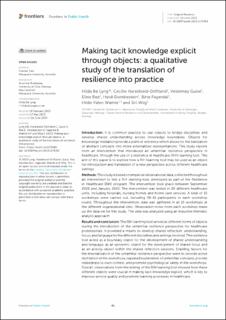| dc.contributor.author | Lyng, Hilda Bø | |
| dc.contributor.author | Haraldseid-Driftland, Cecilie | |
| dc.contributor.author | Guise, Veslemøy | |
| dc.contributor.author | Ree, Eline | |
| dc.contributor.author | Dombestein, Heidi | |
| dc.contributor.author | Fagerdal, Birte | |
| dc.contributor.author | Wæhle, Hilde Valen | |
| dc.contributor.author | Wiig, Siri | |
| dc.date.accessioned | 2023-09-06T08:20:47Z | |
| dc.date.available | 2023-09-06T08:20:47Z | |
| dc.date.created | 2023-06-26T09:28:07Z | |
| dc.date.issued | 2023-06 | |
| dc.identifier.citation | Lyng, H.B., Haraldseid-Driftland, C., Guise, V., Ree, E., Dombestein, H., Fagerdal, B., Wæhle, H.V. & Wiig, S. (2023) Making tacit knowledge explicit through objects: a qualitative study of the translation of resilience into practice. Frontiers in Public Health, 11 | en_US |
| dc.identifier.issn | 2296-2565 | |
| dc.identifier.uri | https://hdl.handle.net/11250/3087662 | |
| dc.description.abstract | Introduction: It is common practice to use objects to bridge disciplines and develop shared understanding across knowledge boundaries. Objects for knowledge mediation provide a point of reference which allows for the translation of abstract concepts into more externalized representations. This study reports from an intervention that introduced an unfamiliar resilience perspective in healthcare, through the use of a resilience in healthcare (RiH) learning tool. The aim of this paper is to explore how a RiH learning tool may be used as an object for introduction and translation of a new perspective across different healthcare settings.
Methods: This study is based on empirical observational data, collected throughout an intervention to test a RiH learning tool, developed as part of the Resilience in Healthcare (RiH) program. The intervention took place between September 2022 and January 2023. The intervention was tested in 20 different healthcare units, including hospitals, nursing homes and home care services. A total of 15 workshops were carried out, including 39-41 participants in each workshop round. Throughout the intervention, data was gathered in all 15 workshops at the different organizational sites. Observation notes from each workshop make up the data set for this study. The data was analyzed using an inductive thematic analysis approach.
Results and conclusion: The RiH learning tool served as different forms of objects during the introduction of the unfamiliar resilience perspective for healthcare professionals. It provided a means to develop shared reflection, understanding, focus, and language for the different disciplines and settings involved. The resilience tool acted as a boundary object for the development of shared understanding and language, as an epistemic object for the development of shared focus and as an activity object within the shared reflection sessions. Enabling factors for the internalization of the unfamiliar resilience perspective were to provide active facilitation of the workshops, repeated explanation of unfamiliar concepts, provide relatedness to own context, and promote psychological safety in the workshops. Overall, observations from the testing of the RiH learning tool showed how these different objects were crucial in making tacit knowledge explicit, which is key to improve service quality and promote learning processes in healthcare. | en_US |
| dc.language.iso | eng | en_US |
| dc.publisher | Frontiers Media S.A | en_US |
| dc.rights | Navngivelse 4.0 Internasjonal | * |
| dc.rights.uri | http://creativecommons.org/licenses/by/4.0/deed.no | * |
| dc.subject | resiliens | en_US |
| dc.subject | helsefag | en_US |
| dc.subject | kvalitativ studie | en_US |
| dc.title | Making tacit knowledge explicit through objects: a qualitative study of the translation of resilience into practice | en_US |
| dc.type | Peer reviewed | en_US |
| dc.type | Journal article | en_US |
| dc.description.version | publishedVersion | en_US |
| dc.rights.holder | © 2023 The Author(s). | en_US |
| dc.subject.nsi | VDP::Medisinske Fag: 700::Helsefag: 800::Sykepleievitenskap: 808 | en_US |
| dc.source.volume | 11 | en_US |
| dc.source.journal | Frontiers in Public Health | en_US |
| dc.identifier.doi | 10.3389/fpubh.2023.1173483 | |
| dc.identifier.cristin | 2157770 | |
| dc.relation.project | SHARE - Centre for Resilience in Healthcare: 5091 | en_US |
| dc.relation.project | Norges forskningsråd: 275367 | en_US |
| cristin.ispublished | true | |
| cristin.fulltext | original | |
| cristin.qualitycode | 1 | |

